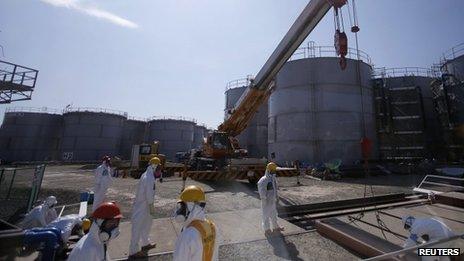Power at Fukushima nuclear fuel ponds restored
- Published

Engineers have been working for more than two years to stabilise the plant
Power has been restored to all fuel pond cooling systems at the damaged Fukushima nuclear plant in Japan, operator Tepco says.
A power cut shut down cooling systems for four spent fuel ponds at reactors 1, 3 and 4 on Monday evening, although cooling to the reactors themselves was not affected.
All cooling systems were operational by early Wednesday morning, .
Pool temperatures remained within safe levels throughout, it added.
Cooling at the spent fuel ponds at reactors 1, 3 and 4 were all restored by 22:43 local time (14:43 GMT on Tuesday).
The cooling system at the fourth, common, pond was restored at 00:12 on Wednesday, Tokyo Electric Power Company (Tepco) said.
'Faulty switchboard'
The cause of the power failure was still being investigated, as Tepco had made restoring power the priority, spokesman Masayuki Ono said, according to Kyodo news agency.
A faulty power switchboard could have caused the power outage, Mr Ono said.
He added that it was the first time so many facilities had been affected by electrical failure at the same time since the plant was brought under control in December 2011.
Restarting cooling to the spent fuel pool at reactor 4 had been of particular urgency for Tepco as it had the highest number of fuel assemblies stored there, Kyodo news agency reported.
The company has been criticised for its delay in announcing the incident, which began at 18:57 on Monday. It took Tepco three hours to announce that the cooling systems had been shut down.
The ponds store spent fuel from the nuclear reactors. They cool the fuel - which generates intense heat - and provide shielding from radiation. The spent fuel remains in the ponds for a year or more.
There was no immediate threat of a radiation release. But if cooling systems had not been restored, it is possible that the water in the ponds could have started to boil.
That could have led to a loss of water and eventually to the exposure of the spent fuel rods to air, releasing radiation.
On 11 March 2011, an earthquake and tsunami crippled the plant. Waves knocked out cooling systems to the reactors, leading to meltdowns at three of them.
Engineers have since stabilised the plant but years of work lie ahead to fully contain the disaster and tackle its effects.
Tens of thousands of evacuees remain unable to return home.
- Published11 March 2013
- Published28 February 2013
- Published21 July 2011
- Published9 July 2012